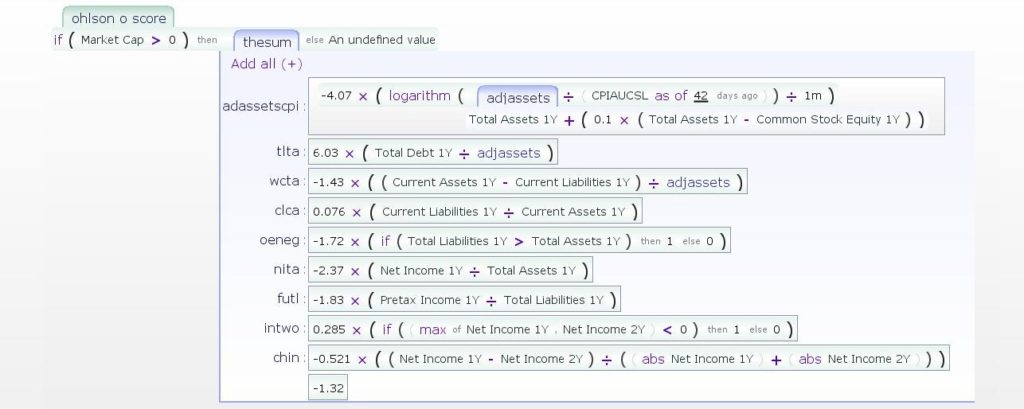If you’re a short seller, then I’d like to introduce you to the Ohlson O-Score. This is a score created by Dr. James Ohlson of New York University, aimed at predicting a company’s financial distress. The Ohlson O-Score results from a nine-factor linear combination of coefficient-weighted accounting ratios found in publicly traded companies’ financial disclosure statements. Below is the actual formula for the Ohlson O- Score.
Ohlson O-Score Formula


From the initial glance, it looks very complex. Well, that’s because it is. For the purpose of understanding what exactly this equation is composed of, let’s break it down piece by piece. Below, the equation is presented again with the variables defined. Two of the factors of the equation are generally considered useless since their value in the formula is typically zero.
TA = Total assets CA= Current Assets
GNP= Gross National Product Index level X= 1 if TL > TA, (otherwise it’s 0)
TL= Total Liabilities NI= Net Income
WC = Working Capital FFO= Funds from Operations
CL= Current Liabilities
Y= 1 if a net loss for the last two years (otherwise, it’s 0)
But just how accurate is it? Any company that results with a score greater than .5 indicates the company has a high chance of bankruptcy. Let’s back-test the Ohlson O-Score and see how accurate it has been in recent times.
The Results
Below is the heat map and back-tested chart of the Ohlson O-Score from the last 2 years.
Heat Map of the Ohlson Score > 10

Great job, Ohlson! There’s vastly more red than green, signaling much danger ahead.

As you can clearly see, it is accurate for determining various company failures. Let’s see what kind of difference we get when we increase the score result from >.5 all the way to >10.
The Results Round 2
The heat map shows that biotech companies are commonly under financial stress for reasons I discussed in a previous article about the biotech industry specifically. It is also important to note that some of these companies did not fail and instead ended up having tremendous returns, such as Loxo Oncology which ended up having a 394.12% return in just two years’ time. This shows that the Ohlson O-Score cannot account for various economic and industry-specific factors. Nevertheless, the Ohlson O-score can still be helpful when looking at a company’s financial distress.

Takeaways
The Ohlson O-Score screener definitely helps you either find companies to short-sell or find companies to avoid. As I said earlier, the Ohlson O-Score cannot account for various economic conditions and industry-specific factors. If you think you can do better than the Ohlson O-Score or even improve on it, then build your own score. Equities Lab offers you an immense amount of data spanning all the way back to 1995, so take advantage of that to build the perfect score.